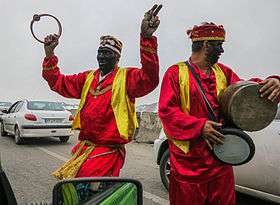Hajji Firuz
Hajji Firuz (Persian: حاجی فیروز – Hāji Firuz) or Khwaja Piruz (Persian: خواجه پیروز – Xwāje Piruz),[1] also spelled Haji Firuz, is a fictional character in Iranian folklore who appears in the streets by the beginning of Nowruz. His face is covered in soot, and he is clad in bright red clothes and a felt hat. He dances through the streets while singing and playing a tambourine.
Etymology
The actual origin and meaning of the term Haji Firuz is obscure. However, it is comprehensibly a term used after the Arab conquest of Iran, as many Iranian words and titles were transformed by the Arabic language.
Haji, as written with the eighth letter of Perso-Arabic alphabet (حاجى), has a meaning unrelated to that of the word Hajji; it is a form of address, much like using sir to address a person in English, without the person being a knight. As written with the penultimate letter of the Perso-Arabic alphabet (هاجی), it derives from the word heja (هجاء), meaning 'satire'.[2] Firuz is the Arabized version of the Persian word piruz, meaning 'victor'.
Khwaje Piruz is the other version of the term, which consists of the word khwaje, identified as an Iranian title meaning 'master', and the non-Arabized piruz.
History
In the traditional songs, he introduces himself as a serf trying to cheer people whom he refers to as his lords. As a black-faced serf, he is a controversial character, seen as symbolically racist.[3] Therefore, half of his face is sometimes painted white in order to avoid the criticisms.
According to some sources, Haji Firuz is based on a tradition called Mir Nowruzi. Mir Nowruz was a comical figure chosen to rule the municipality for "the last five days of the year" (Panje). The temporary "five-day king" (Šāh e Panj Ruze) would often parade the city with a group of singers and dancers for the Nowruz celebrations.[4]
Mehrdad Bahar, a prominent Persian historian, opined in 1983 that the figure of Haji Firuz may be derived from ceremonies and legends connected to the epic of Prince Siavash, which are in turn derived from those associated with the Mesopotamian deity of agriculture and flocks, Tammuz (Sumerian Dumuzi).[5][6] Later, it was claimed that the blackened face of Haji Firuz symbolizes his returning from the world of the dead,[1] his red clothing is the sign of the blood of Siavash and the coming to life of the sacrificed deity, while his joviality is the jubilation of rebirth, typical of those who bring rejuvenation and blessing along with themselves. Bahar speculates that the name Siyāwaxš might mean 'black man' or 'dark-faced man' and suggests that the term black in the name may be a reference either to the blackening of the faces of the participants in the aforementioned Mesopotamian ceremonies, or to the black masks that they wore for the festivities.[7]
Typical songs

Hāji Firouz E!
Hāji firuz e, sāl-i ye ruz e (It’s Haji Firuz, it’s only one day a year)
Hame midunan, man am midunam (Everyone knows, I know as well)
Eyd e Nowruz e, sāl-i ye ruz e (It's Nowruz, it’s only one day a year)
Arbāb e Xod am
Arbāb e xod am, "sāmmule baleykom" (Greetings, my lord)
Arbāb e xod am, sar et-o bālā kon (Raise your head, my lord)
Arbāb e xod am, lotf-i be mā kon (Do me a favor, my lord)
Arbāb e xod am, be man nigā kon (Look at me, my lord)
Arbāb e xod am, boz-boz e qandi (My lord, the billy goat)
Arbāb e xod am, čerā nemi-xandi? (Why don’t you smile, my lord?)[7]
Beškan Beškan
Beškan beškan e, beškan! (It's a snap-snap, snap!)
Man nemi-škanam, beškan! (I won't snap, snap!)
Injā beškanam, yār gele dāre (If I snap here, this one will complain)
Unjā beškanam, yār gele dāre (If I snap there, that one will complain)
In siāh e bičāre če qad howsele dāre! (How patient this poor black [man] is!)
See also
- Zwarte Piet
- Border Morris
- Knecht Ruprecht
- Amu Nowruz ('Uncle Nowruz')
- Siuda Baba
References
- 1 2 "Noruz". traditionscustoms.com. Retrieved 2018-09-02.
- ↑ John Richardsohn:Wilkens, Charles, ed. (1810). . London: F. & C. Rivingson, p. 626 and p. 628
- ↑ Faces around the World: A Cultural Encyclopedia of the Human Face By Margo DeMello – Black Face, Page 28
- ↑ According to research by Dr. Mahmoud Roh-ol-Amini based on the writings of Allamah Mohammad Ghazvini on "Mir-Norouzi" in the early twentieth century.
- ↑ "Haji Firuz As Iranian Blackface: Why the Iranian-American Community Needs To End This Tradition". The Iranian. 2018-04-02. Retrieved 2018-09-02.
- ↑ Baghoolizadeh, Beeta (2012-06-20). "The Afro-Iranian Community: Beyond Haji Firuz Blackface, the Slave Trade, & Bandari Music". Ajam Media Collective. Retrieved 2018-09-02.
- 1 2 Omidsalar, Mahmoud. "ḤĀJI FIRUZ". Encyclopedia Iranica. Retrieved 2012-01-08.
Books
- Richardson, John.Wilkens, Charles, ed. (1810). . London: F. & C. Rivingson. [OCLC: 5631372]
- Ghanoonparvar, Mohammad.R.: In a Persian Mirror: Images of the West and Westerners in Iranian Fiction, Uni Press Texas, U.S.A. 1993 ISBN 978-0-292-72761-8
External links
| Wikimedia Commons has media related to Haji Firuz. |
- Ḥāji Firuz article by Encyclopædia Iranica
- The Persian Nowruz By Iraj Bashiri
- Haji Firuz: The Traditional Herald of Norouz